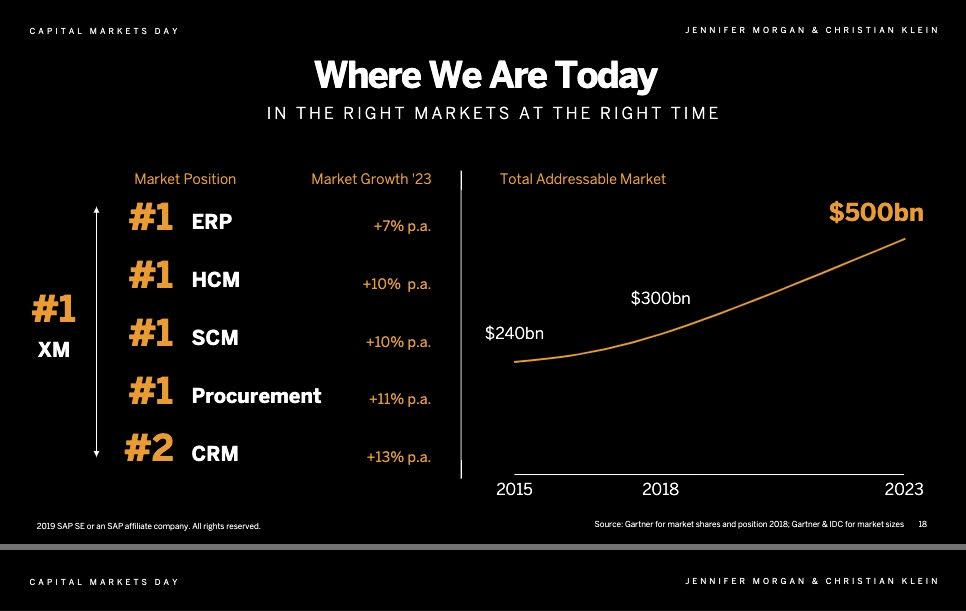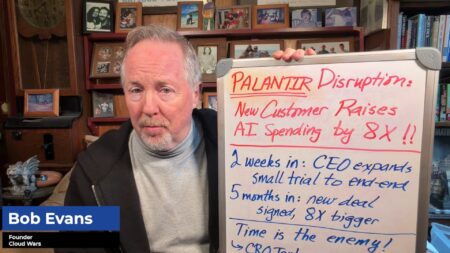In a 4-hour coming-out party with the financial-analyst community, SAP’s new co-CEOs fully committed to the company’s growth plans in the cloud and beyond, while vowing to make customer success SAP’s #1 priority and to exterminate product silos and low-growth vestiges of the company’s past.
Speaking proudly of SAP’s heritage and the huge legacy of outgoing CEO Bill McDermott, new co-CEOs Jennifer Morgan and Christian Klein also made it unmistakably clear yesterday that they will bring much greater focus and rigor to SAP’s product strategy and development priorities.
The results will be a company and a vast fleet of on-premises and cloud solutions geared toward what modern customers say they want and need, rather than to preserving and stringing along increasingly obscure or low-impact products.
“I want to be very clear: we will have one set of priorities across the company, not a lot of different priorities for different parts of the organization,” Morgan said.
“We’re going to remove all those product silos, remove all those redundancies, and align everything we do with the business outcomes of our customers.”
Where SAP is Now: Siloed Fiefdoms
Like a lot of big companies, SAP had developed numerous product fiefdoms. Each has its own budget, its own priorities, its own timetable, and its own views of what customers do or don’t want and need.
As a result, Morgan said, customers were frequently being confronted by fragmented and often overlapping product roadmaps. And siloed SAP sales teams were in essence competing against each other, to the detriment of SAP.
Earlier this year, Morgan said, when she took over the company’s Cloud Business Unit, she asked the development team if they knew what their priorities were. They replied that they did not have a clear set of priorities. As a result, fragmented product groups were constantly battling with one another and with the development organization for resources and top spots on the pecking order, Morgan said.
“Our development teams are the best,” Morgan said. “But for them to be able to unleash their best work, they need clear and consistent guidance from us, and they haven’t had that.”
Where SAP is Headed: Unification and Transparency
So Morgan and Klein have set in place a new product-development strategy. They’ve designed it to yield a single, unified and companywide list of priorities that’s visible to all and based on three sets of input: market reality, product reality and financial reality.
“So we’re really focusing on questions like, are we investing only in growth areas, or are we still investing in some flat areas? And if so, why are we doing that?
“With the speed of the business world today, the time to value has decreased dramatically—and as a result, we need to think very differently about how we’re bringing products to market,” Morgan said.
The goals are to stop the always confusing and often harmful practice of having different sales teams offering different solutions to the same customer, and to become more operationally efficient.
“To do that, we’re breaking down silos and ensuring we’ve all got the same priorities. We’re removing redundancies in our product lines to eliminate overlap. And we’re de-investing in some long-tail solutions that just don’t measure up to today’s market realities,” Morgan said.
SAP Says It’s “In the Right Markets at the Right Time”

Co-CEO Klein showed a slide (above) stating that SAP is the #1 global leader in ERP, HCM, SCM, Procurement, and Experience Management, and that it’s #2 in CRM.
Those categories will represent a $500-billion market by 2023, Klein said. For SAP to meet its own growth targets within that opportunity, it will have to simplify some sales processes and devote all of its end-to-end energies to customer success.
“Sales must be accountable beyond the transaction to the ultimate business outcome. Service and Support must be committed to exceeding customer expectations. And Development must meet the very highest quality standards and user-experience standards,” Klein said.
He emphasized that this goal spans the entire company and will impact the “compensation blends” of all SAP people.
Klein also hammered on the company’s past willingness to let product overlaps confuse the marketplace.
“Sometimes we offer different solutions for the same customer problems—that has to stop,” Klein said. “That’s good for the customer, and, by better integrating our products, we can also create synergies inside the organization.
“Customers tell us that it doesn’t always feel like they’re dealing with one SAP. They want less hierarchy, less bureaucracy, less overlap in solutions.”
Disclosure: at the time of this writing, SAP was a client of Evans Strategic Communications LLC.
Subscribe to the Cloud Wars Newsletter for in-depth analysis of the major cloud vendors from the perspective of business customers. It’s free, it’s exclusive, and it’s great!








